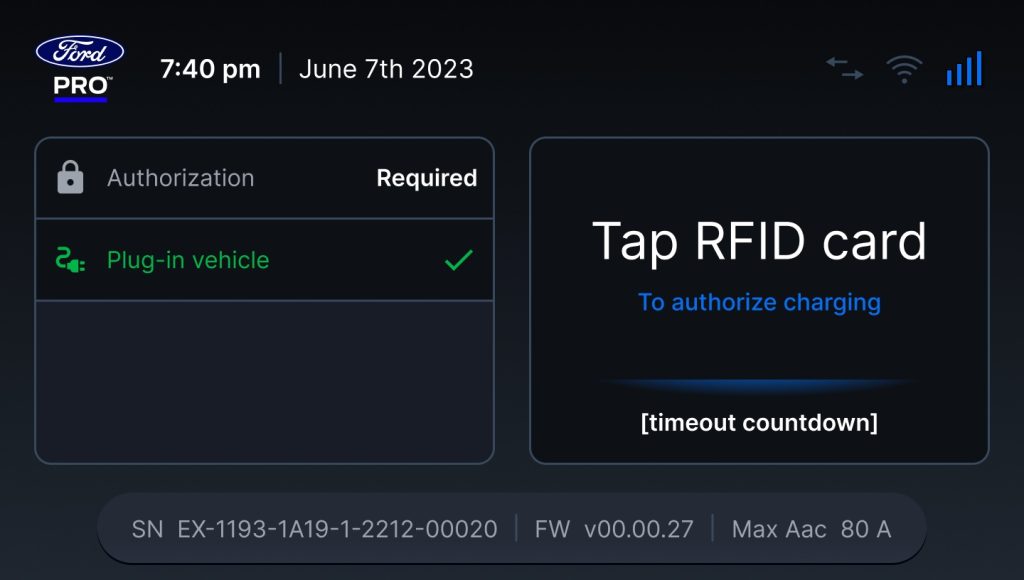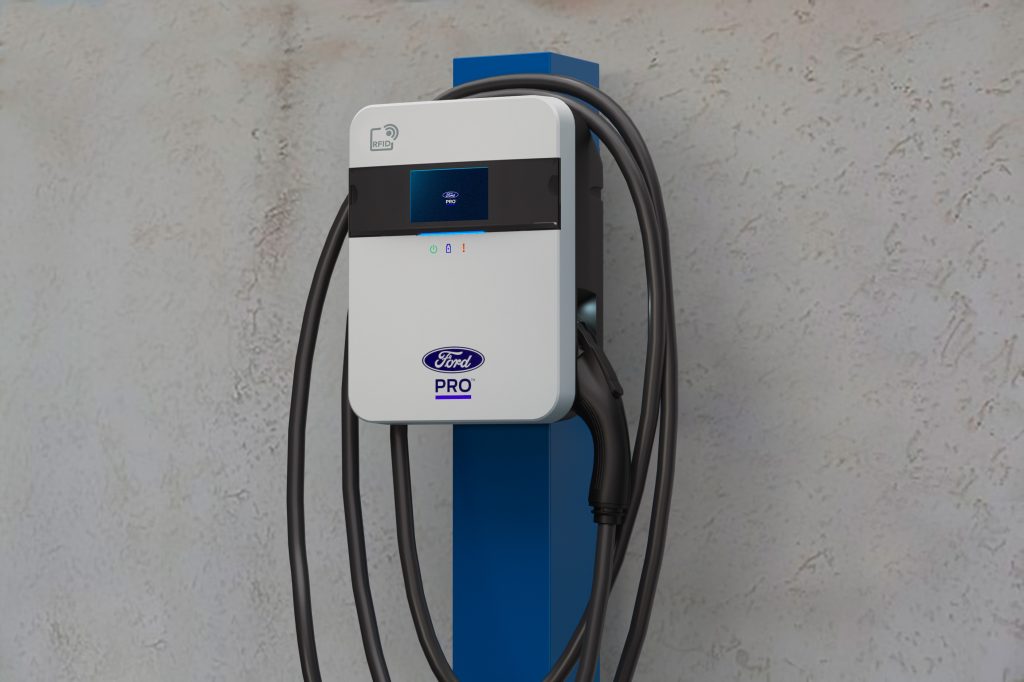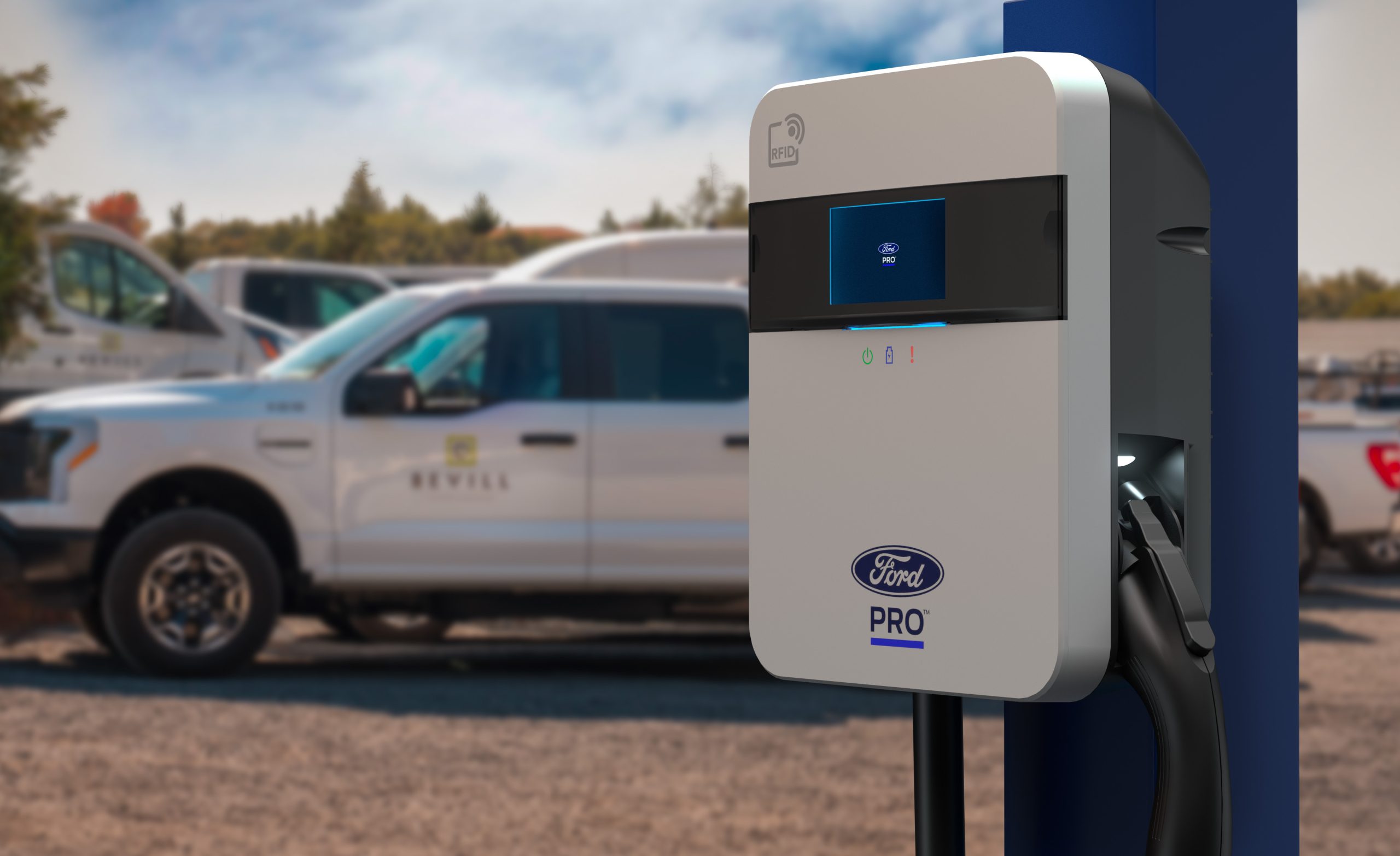Ford Pro, the legacy OEMs commercial division, unveiled new charging solutions tailored for commercial customers’ electrified fleets.
Ford Pro informed Teslarati about its newly designed Series 2 AC Charging Station 80 amp and expanded DC Fast Chargers for commercial vehicle fleets. Both charging solutions work with Ford Pro’s charging management software, which works with Ford and non-Ford electric vehicles. The automaker claims its latest commercial charging solutions are easier to use, service, and control.
The Series 2 AC charger has a detachable cable and connector. It also has an RFID reader and increased connectivity. The AC charger is also designed with the future in mind. As Ford Pro states, it is “primed for future standards and over-the-air updates.” Below are the Series 2 AC’s charger’s features
- Enhanced security with RFID that limits unwanted charger access. Fleet operators can issue a unique Ford Pro RFID card1 to control access to chargers, enabling charging sessions to be limited to specific individuals or vehicles by specifying days and times for access. The new RFID software also supports Ford and non-Ford vehicles, unlocking the ability for fleet operators to track energy reports through Ford Pro’s charging management software.
- Improved detachable cable and connector reduces time and expense of charger repairs, avoiding replacement of the entire charging station if a cable or connector is damaged.
- Wide range of connectivity options with cellular pre-configured and optional Wi-Fi and Ethernet connectivity for locations with restricted cellular coverage.
- The new Series 2 AC Charging Station 80 Amp will be ISO-15118 ready and equipped to enable future functionality over the air, such as advanced vehicle-to-charger communications that can identify and log when a specific vehicle connects. Ford Pro designed the new hardware to be ready for the future so customers are better prepared for new electric vehicles and future capabilities.
- The new LCD screen on the Series 2 charger displays step-by-step instructions to initiate charging and essential information, including charge duration, fault alerts, energy usage, and more.
- Temperature sensors to monitor and alert for overheating by derating the charger automatically.
- Extended operating temperature range of -40C (-40F) to 50C (122F) and operating altitude of up to 3500m to serve the needs of customers in more places.
- The new Ford Pro charging hardware is backed by a 3-year warranty on charger parts and labor and continues to provide around-the-clock tech support to help increase uptime and productivity for customers.
- Ford Pro Telematics, chargers, software, and service work seamlessly to provide fleet operators and managers with a single solution to monitor their vehicle network 24/7.



Ford Pro customers can choose between the extended DC Fast Charger options: 180 kW and 240 kW. The Series 2 AC Charging station and DC Fast Charger are available for pre-order now.
The legacy automaker also provides customers with access to the BEV Fit team. The BEV Fit team offers complimentary consulting to customers who have electric fleets and are transitioning or are thinking of transitioning to electric commercial vehicles. The team helps customers find available incentives for their fleet. Ford Pro customers can consult the BEV Fit team regarding their charging site design and construction needs. They may also turn to the team for help collaborating with local utilities to meet their energy needs.
The Teslarati team would appreciate hearing from you. If you have any tips, contact me at maria@teslarati.com or via X @Writer_01001101.

Elon Musk
Elon Musk and Tesla AI Director share insights after empty driver seat Robotaxi rides
The executives’ unoccupied tests hint at the rapid progress of Tesla’s unsupervised Robotaxi efforts.

Tesla CEO Elon Musk and AI Director Ashok Elluswamy celebrated Christmas Eve by sharing personal experiences with Robotaxi vehicles that had no safety monitor or occupant in the driver’s seat. Musk described the system’s “perfect driving” around Austin, while Elluswamy posted video from the back seat, calling it “an amazing experience.”
The executives’ unoccupied tests hint at the rapid progress of Tesla’s unsupervised Robotaxi efforts.
Elon and Ashok’s firsthand Robotaxi insights
Prior to Musk and the Tesla AI Director’s posts, sightings of unmanned Teslas navigating public roads were widely shared on social media. One such vehicle was spotted in Austin, Texas, which Elon Musk acknowleged by stating that “Testing is underway with no occupants in the car.”
Based on his Christmas Eve post, Musk seemed to have tested an unmanned Tesla himself. “A Tesla with no safety monitor in the car and me sitting in the passenger seat took me all around Austin on Sunday with perfect driving,” Musk wrote in his post.
Elluswamy responded with a 2-minute video showing himself in the rear of an unmanned Tesla. The video featured the vehicle’s empty front seats, as well as its smooth handling through real-world traffic. He captioned his video with the words, “It’s an amazing experience!”
Towards Unsupervised operations
During an xAI Hackathon earlier this month, Elon Musk mentioned that Tesla owed be removing Safety Monitors from its Robotaxis in Austin in just three weeks. “Unsupervised is pretty much solved at this point. So there will be Tesla Robotaxis operating in Austin with no one in them. Not even anyone in the passenger seat in about three weeks,” he said. Musk echoed similar estimates at the 2025 Annual Shareholder Meeting and the Q3 2025 earnings call.
Considering the insights that were posted Musk and Elluswamy, it does appear that Tesla is working hard towards operating its Robotaxis with no safety monitors. This is quite impressive considering that the service was launched just earlier this year.
Elon Musk
Starlink passes 9 million active customers just weeks after hitting 8 million
The milestone highlights the accelerating growth of Starlink, which has now been adding over 20,000 new users per day.

SpaceX’s Starlink satellite internet service has continued its rapid global expansion, surpassing 9 million active customers just weeks after crossing the 8 million mark.
The milestone highlights the accelerating growth of Starlink, which has now been adding over 20,000 new users per day.
9 million customers
In a post on X, SpaceX stated that Starlink now serves over 9 million active users across 155 countries, territories, and markets. The company reached 8 million customers in early November, meaning it added roughly 1 million subscribers in under seven weeks, or about 21,275 new users on average per day.
“Starlink is connecting more than 9M active customers with high-speed internet across 155 countries, territories, and many other markets,” Starlink wrote in a post on its official X account. SpaceX President Gwynne Shotwell also celebrated the milestone on X. “A huge thank you to all of our customers and congrats to the Starlink team for such an incredible product,” she wrote.
That growth rate reflects both rising demand for broadband in underserved regions and Starlink’s expanding satellite constellation, which now includes more than 9,000 low-Earth-orbit satellites designed to deliver high-speed, low-latency internet worldwide.
Starlink’s momentum
Starlink’s momentum has been building up. SpaceX reported 4.6 million Starlink customers in December 2024, followed by 7 million by August 2025, and 8 million customers in November. Independent data also suggests Starlink usage is rising sharply, with Cloudflare reporting that global web traffic from Starlink users more than doubled in 2025, as noted in an Insider report.
Starlink’s momentum is increasingly tied to SpaceX’s broader financial outlook. Elon Musk has said the satellite network is “by far” the company’s largest revenue driver, and reports suggest SpaceX may be positioning itself for an initial public offering as soon as next year, with valuations estimated as high as $1.5 trillion. Musk has also suggested in the past that Starlink could have its own IPO in the future.
News
NVIDIA Director of Robotics: Tesla FSD v14 is the first AI to pass the “Physical Turing Test”
After testing FSD v14, Fan stated that his experience with FSD felt magical at first, but it soon started to feel like a routine.

NVIDIA Director of Robotics Jim Fan has praised Tesla’s Full Self-Driving (Supervised) v14 as the first AI to pass what he described as a “Physical Turing Test.”
After testing FSD v14, Fan stated that his experience with FSD felt magical at first, but it soon started to feel like a routine. And just like smartphones today, removing it now would “actively hurt.”
Jim Fan’s hands-on FSD v14 impressions
Fan, a leading researcher in embodied AI who is currently solving Physical AI at NVIDIA and spearheading the company’s Project GR00T initiative, noted that he actually was late to the Tesla game. He was, however, one of the first to try out FSD v14.
“I was very late to own a Tesla but among the earliest to try out FSD v14. It’s perhaps the first time I experience an AI that passes the Physical Turing Test: after a long day at work, you press a button, lay back, and couldn’t tell if a neural net or a human drove you home,” Fan wrote in a post on X.
Fan added: “Despite knowing exactly how robot learning works, I still find it magical watching the steering wheel turn by itself. First it feels surreal, next it becomes routine. Then, like the smartphone, taking it away actively hurts. This is how humanity gets rewired and glued to god-like technologies.”
The Physical Turing Test
The original Turing Test was conceived by Alan Turing in 1950, and it was aimed at determining if a machine could exhibit behavior that is equivalent to or indistinguishable from a human. By focusing on text-based conversations, the original Turing Test set a high bar for natural language processing and machine learning.
This test has been passed by today’s large language models. However, the capability to converse in a humanlike manner is a completely different challenge from performing real-world problem-solving or physical interactions. Thus, Fan introduced the Physical Turing Test, which challenges AI systems to demonstrate intelligence through physical actions.
Based on Fan’s comments, Tesla has demonstrated these intelligent physical actions with FSD v14. Elon Musk agreed with the NVIDIA executive, stating in a post on X that with FSD v14, “you can sense the sentience maturing.” Musk also praised Tesla AI, calling it the best “real-world AI” today.










